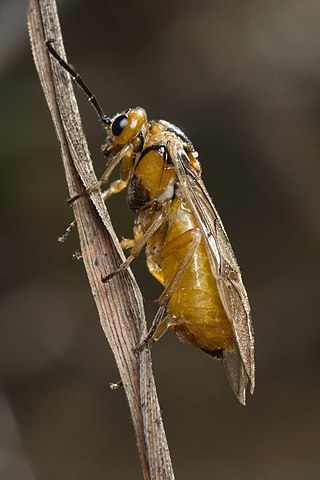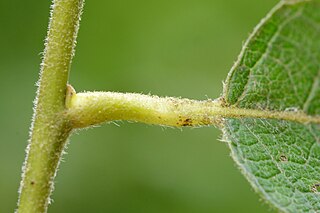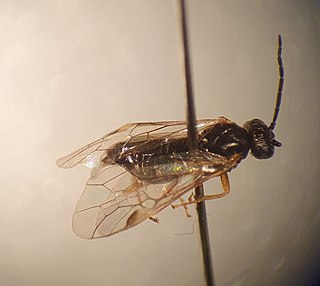
Galls or cecidia are a kind of swelling growth on the external tissues of plants, fungi, or animals. Plant galls are abnormal outgrowths of plant tissues, similar to benign tumors or warts in animals. They can be caused by various parasites, from viruses, fungi and bacteria, to other plants, insects and mites. Plant galls are often highly organized structures so that the cause of the gall can often be determined without the actual agent being identified. This applies particularly to some insect and mite plant galls. The study of plant galls is known as cecidology.

Tenthredinidae is the largest family of sawflies, with well over 7,500 species worldwide, divided into 430 genera. Larvae are herbivores and typically feed on the foliage of trees and shrubs, with occasional exceptions that are leaf miners, stem borers, or gall makers. The larvae of externally feeding species resemble small caterpillars. As with all hymenopterans, common sawflies undergo complete metamorphosis.

Nematinae is a subfamily of sawflies belonging to the family Tenthredinidae. It contains over 1250 described species in ~40 genera. Members of this subfamily feed on a wide range of plants and employ a wide range of feeding habits, both internally and externally, on their host plants.

Nematus oligospilus, commonly known as the willow sawfly, is a species of sawfly in the family Tenthredinidae. Native to central and northern Europe and Asia, it was first recorded in South America in the 1980s and New Zealand in 1997, and has also been introduced to Australia, South Africa and Lesotho. Its larvae feed on the leaves of various species of willow.

Euura is a genus of sawflies of the family Tenthredinidae, subfamily Nematinae. Some of the larvae feed externally on plants and some form plant galls on willows (Salix species). In the case of the gall-forming species, when the female lays her eggs she injects a stimulant and the gall starts to form before the eggs hatch. Most sawfly galls are hard and individual larva tend to inhabit the gall, feeding on the tissue and leave the gall to pupate in the soil. Most of the species are monophages although the type species, Euura mucronata, is polyphagous feeding on over thirty species of willow.
Euura mucronata is a species of sawfly belonging to the family Tenthredinidae. The larva feed within galls on the buds of willows. It was first described by Theodor Hartig in 1837.
Euura amerinae is a species of sawfly belonging to the family Tenthredinidae. The larvae form galls on bay willow. It was first described by Carl Linnaeus in 1758.
Euura auritae is a species of sawfly belonging to the family Tenthredinidae. The larvae forms galls on willows. It was first described by Jens-Peter Kopelke in 2000. E. auritae is one of a number of closely related species which is known as the Euura atra subgroup.
Euura weiffenbachiella is a species of sawfly belonging to the family Tenthredinidae. The larvae forms galls on creeping willows. E. weiffenbachiella is one of a number of closely related species which is known as the Euura atra subgroup.
Euura myrtilloides is a species of sawfly belonging to the family Tenthredinidae and the larvae forms galls on swamp willow. It was first described by Jens-Peter Kopelke in 1996. E. myrtilloides is one of a number of closely related species which is known as the Euura atra subgroup.

Euura venusta is a species of sawfly belonging to the family Tenthredinidae. The larvae feed within the leaf-stalk of willows forming a gall. The sawfly was first described by Carl Gustav Alexander Brischke in 1883.
Euura testaceipes is a species of sawfly belonging to the family Tenthredinidae. The larvae feed within the leaf-stalk (petiole), or midrib of a leaf, on willows forming a gall. The sawfly was first described by Carl Gustav Alexander Brischke in 1883. E. testaceipes is one of three closely related species known as the Euura amerinae species subgroup. The other members of the group are E. amerinae and E. venusta
Euura dolichura is a species of sawfly belonging to the family Tenthredinidae. It was first described by Carl Gustaf Thomson in 1871. The larvae feed within galls on the leaves of willow. Some of the Euura species of sawfly are closely related and placed in groups of similar species. E. dolichura is a member of the Euura dolichura species group.

Euura proxima is a species of sawfly belonging to the family Tenthredinidae. The larvae feed on the leaves of willows, creating galls and was described by Jean Guillaume Audinet-Serville in 1823.
Euura triandrae is a species of sawfly belonging to the family Tenthredinidae. The larvae feed on the leaves of almond willow and was first described in 1941.
Euura bridgmanii is a species of sawfly belonging to the family Tenthredinidae. The larvae feed on the leaves of sallows. It was first described by the entomologist Peter Cameron in 1883.
Euura pustulator is a species of sawfly belonging to the family Tenthredinidae. The larvae feed internally in a gall formed on the leaves of tea-leaved willow and diamondleaf willow.
Euura herbaceae is a species of sawfly belonging to the family Tenthredinidae. The larvae feed internally in a gall formed on the leaves of dwarf willow and polar willow. Galls of E. aquilonis are similar and the larvae need to be examined to tell them apart.

Euura viminalis is a species of sawfly belonging to the family Tenthredinidae. The larva feed within galls on the leaves of willows. It was first described by Carl Linnaeus in his landmark 1758 10th edition of Systema Naturae.

Pontania californica, generally known as the willow apple gall sawfly, is a species of common sawfly in the family Tenthredinidae.









